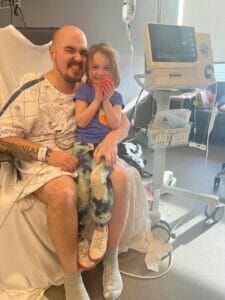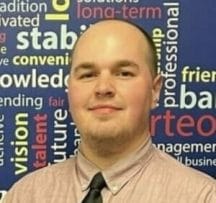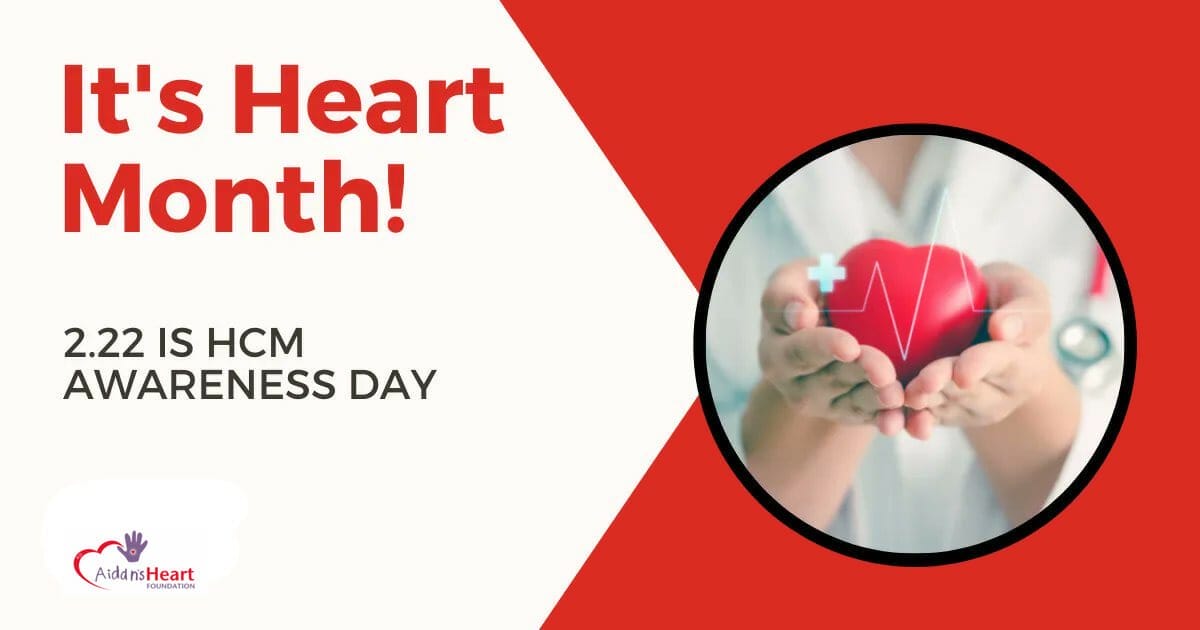It’s so crazy how normal everything can seem, and then suddenly it’s not. And by then, it’s too late.
Today is National HCM Awareness Day. Hypertrophic cardiomyopathy, or HCM, often goes undiagnosed, is progressive, and cannot be detected with a stethoscope. Most children and adults with HCM don’t show symptoms. The only way to detect HCM is by testing the heart with an EKG and echocardiogram, which Aidan’s Heart Foundation has provided through free heart screening events since 2011. Please help us share Nick’s story and honor his courage by making a donation TODAY toward our heart screening efforts.

Meet Nicholas Madrigale. Nick will be 32 years old in April. He keeps in shape. Father of two beautiful daughters, ages 5 and 2, and two stepsons. Nick grew up in Downingtown– he went to West Bradford Elementary, then to DMS, then West High School, class of 2009. His last name was Detterline back then.
Here’s another fact about Nick. Since December 28th, he’s been in the cardiac ICU unit at HUP awaiting a heart transplant. He was told to expect a wait time of six weeks before he’d receive his new heart. That was 8 weeks ago.
Nick, since age 5, has been living with Hypertrophic Cardiomyopathy, or HCM. According to the American Heart Association, 1 in every 500 adults living in the U.S. has HCM. A large percentage of patients are undiagnosed. HCM affects kids, too. While we’re still learning about hypertrophic cardiomyopathy in youth, it is estimated that HCM has a prevalence of approximately 1 in every 1,000 to 2,500 kids and teens. HCM causes the muscle cells to become enlarged (hypertrophy), thickening the walls of the heart and disrupting its rhythm and ability to pump blood and oxygen through the body. Often, children with HCM are seemingly healthy and have no symptoms. Some may experience lightheadedness, difficulty breathing or chest pain. It is a progressive condition and many children will not show symptoms. HCM has been linked to abnormal heart rhythms that result in syncope (passing out or loss of consciousness), or sudden death. It is a common cause of sudden death in athletes.
HCM can only be detected in seemingly healthy youth by screening the heart with an electrocardiogram (EKG or ECG), an echocardiogram (ECHO), an MRI and/or a holter monitor. At this moment in time, pediatric protocol does not include routine EKG exams for asymptomatic children and teens.
Nick wasn’t so lucky as to be diagnosed with a simple, non-invasive EKG exam. For Nick, two incredibly fortuitous resuscitations and a second opinion led doctors to finally test his heart and learn that HCM was the culprit.
Here’s the story.
Nick was born healthy and had a normal baby and toddler life. One day, when he was four years old, he chased his older brother and mother down the driveway to the bus stop when he suddenly collapsed. Nick’s mom, in her understandable panic, threw Nick over her shoulder to run him back up to the house to call for help. The doctors later said that the way Nick’s body was bumping on his mother’s shoulder actually mimicked the compressions used during cardiopulmonary resuscitation (CPR) and saved his life. But the doctors couldn’t explain what had happened.
A few months later, Nick was running around grandparents house and again collapsed. This time, his quick-thinking grandmother gave him CPR, and Nick regained consciousness.
Again, tests revealed no sign of neurological disorder to explain these “seizures”. No testing was done on his heart.
Undeterred and desperate for answers, Nick’s mother brought him to St. Christopher’s Hospital for a second opinion. Upon the description of his two fainting events, doctors at St. Chris’s immediately screened his heart with an EKG and an MRI and diagnosed Nick with hypertrophic cardiomyopathy. He was five years old.
Many cases of HCM are genetic in nature, and once one family member is diagnosed, other family members should be tested for the condition. HCM can also develop in young people, especially athletes, as a result of prolonged physical exertion.
Nick, at age 5, wasn’t yet an athlete. No one in his family had ever had any cardiac event or issue– no family history of heart disease, heart attack, etc. Nick recounts that his father passed away when Nick was young due to a car accident, and that looking back, it’s possible that it could’ve been related to a cardiac event. But it was a long time ago, and they’ll never know.
Nick has been living with HCM since his diagnosis. He was treated with medication until he was 8 years old. Then, in 1998, Nick underwent surgery and had a “Walkman-sized” implantable cardiodefibrillator (ICD) in his stomach. It was the 90s, he says. Technology has come a long, long way since then.
A few years after his original ICD was implanted, the “Walkman” ICD was removed and a newer, smaller one was placed in his chest. And then 20 years went by. Nick was intentional in choosing the level of his participation in sports and other active pursuits. He didn’t let himself get too stressed. He managed his symptoms. He knew what it would feel like when an episode was approaching; his chest would start thumping fast, and he’d start to feel dizzy, usually during physical activity. But, with the ICD and medicine, he managed his HCM and he managed to live, by most measures, a normal life.
Until two years ago, when it came time for a routine cardiac check-up. On the spot, Nick had surgery for a right heart catheterization and was diagnosed with heart failure. The medicine, doctors told him, was not working anymore. Nick, at the time, was a few months shy of his 30th birthday.

Things quickly went downhill. This past summer, Nick was designated at category 4 – at home with IV medication. Then, on December 28th, Nick was admitted into the hospital’s transplant unit, his status elevated to category 2. On December 31st, a device called Impella was surgically implanted, assisting his heart in pumping blood and oxygen throughout his body. He can’t go home with it; he’s hooked up to the machine, which is called the “bridge” to the transplant. He will not leave the hospital until he has a new heart.
Since the New Year, the time during which many people were making resolutions to quit bad habits or start new, good ones, Nick has had a lot of time to think about the new life that awaits when his new heart comes to him.
He’s decided that he wants to help others by telling his story and helping people learn how to keep each other safe. Being in the hospital and talking to people who have had heart transplants, Nick realizes that although it’s a rough spot, he can get through it, and that his story can inspire education, advocacy, and– change.
He saw our recent social media posts about our annual training of 1,100 sixth grade students in CPR+AED skills, and he lit up.
Getting awareness out to younger people is key,” he says. “(HCM) goes so long undetected and then you don’t often find out until it’s too late– so it’s important to know how to respond to save someone’s life.
He also learned about our free heart screening events. He’s shocked that EKGs are not standard medical practice for young people. Nick remarks, ”(An EKG test) can literally save a life. The test is easy, there’s no pain, and you can get some information and figure things out. You can also protect other family members; when (the tests) find something in one person, they can find it in other people in the same bloodline.”
HCM is one of the more common cardiac anomalies that is largely hereditary. There are different types of HCM. The area that is affected in Nick’s heart is his septum– its thickened walls place stress on his heart as it pumps, and strenuous physical activity induces an irregular rhythm, which can cause heart to stop. “A lot of times,” he says, “it (HCM) goes undetected because we don’t screen for it– it’s scary because you can look so normal, never have a clue until it happens, then a lot of times it’s too late.”
To date, Aidan’s Heart Foundation has tested over 2,000 young hearts with EKG testing, and provided follow-up echocardiogram testing as needed. During our most recent heart screening events, 10 out of 146 and 6 out of 116 teens were identified with potentially life-threatening heart conditions that would not have been picked up by a stethoscope. We are saving lives, arming families with information they wouldn’t otherwise have access to about their children’s heart health, and giving them a chance to take action. Once identified, treatments make it possible for kids to live normal lives– normal, long lives.
Getting an EKG can be scary, however, especially to young athletes who don’t want to be told they can’t play sports anymore. Nick’s advice is this: “If they find something, it doesn’t mean life is over. There’s still so much you can do.” A teen athlete he used to see in the hospital had HCM and played soccer, ran on the treadmill for 20 minutes at a time, which was 15 minutes more than Nick could. “You don’t have to drastically change life,” he says.
When asked about advice to parents in helping to identify potential indicators of HCM, Nick emphatically said, “shortness of breath and dizziness…and don’t be quick to chalk it up to dehydration or something else” He said he’d feel these symptoms “even though I didn’t feel like I earned it”. He remembers getting off the bus, walking 20 steps and feeling like he’d run a flight of stairs– even with medicine and ICD. Nick never felt other classic symptoms that can present with HCM, like rapid palpitations. He attributes this to never having a strong heart to begin with, so his heart simply wasn’t able to “beat out of his chest”. For Nick, his symptoms mimicked those of an anxiety attack– unexpected, sudden, and concerning– but not signaling imminent danger.
Shortness of breath and dizziness…don’t be quick to chalk it up to dehydration or something else. I’d feel these symptoms even though I didn’t feel like I earned it.
And for the 1 in 300 youth screened who is found to have a life-threatening cardiac issue, Nick advises: Trust your doctor. He was a huge hockey fan and really wanted to play hockey, but his doctors said it would be too risky for his heart. Instead, he shifted his perspective. “You’ve gotta use the energy for something else. Yeah, it’s upsetting, but you channel it and figure out a positive way to use it.” He remembers nights as a teenager where he was crying and bawling that he couldn’t participate in strenuous sports. He’d go through it, venting to someone– friends, parents, doctors– and “get it out, channel it.” He urges someone in his shoes, diagnosed with a heart issue, to shift mindsets. He recommends getting into music, or focusing on academics, or even engaging in a different sport that’s not as physical. “Gotta remain positive,” he says. “A lot of stuff will change, but get out of the bad mindset and focus on the positive. Getting diagnosed doesn’t mean your life is over and you can’t do what you want. It’s not a death sentence. You’ll have limitations, but it’s all stuff you can work around.”
Today, February 22nd, is National HCM Awareness Day. It’s no coincidence that Nick reached out to us just a few weeks ago, after seeing our recent posts about training another 1,100 sixth grade students in Hands-Only CPR+AED skills. Nick had the courage to offer to share his story, in the hopes that other families could be educated about HCM, talk about potential symptoms with their kids, and get tested if family history or warning signs indicate a concern. Speaking from experience, sharing one’s difficult life story takes guts– and it takes an emotional toll. Please help us show Nick that his courage and his efforts matter. Please make a donation toward our heart screening fund in Nick’s honor.
When he walks out of HUP with a new heart, we’d like to give him a little wind under his wings as he starts the rest of his life with his new heart by telling him what a difference he’s made, and about the lives your contributions towards our heart screenings will save. Donate today and help us make sure Nick leaves the hospital with not only a new heart, but a full one.

Direct donation link to Nick’s HCM Awareness Day Heart Screening campaign: https://aidansheart.kindful.com/?campaign=1240916

